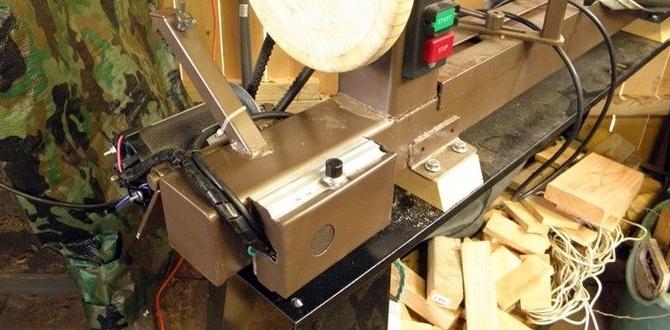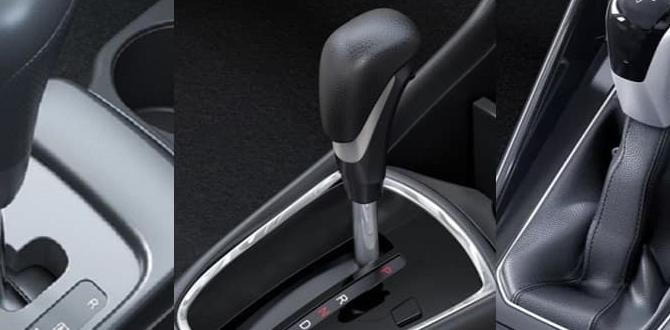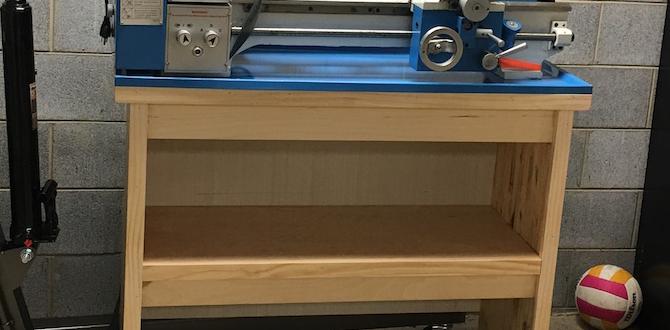For mild steel machining, a TiAlN ball nose end mill is a fantastic choice. It offers superior hardness, heat resistance, and lubricity, enabling efficient trochoidal milling with excellent tool life and surface finish. This makes it ideal for beginners looking for reliable performance.
Hey makers, Daniel Bates here from Lathe Hub! Ever looked at a piece of mild steel and wondered how to carve out those smooth, curved shapes or intricate pockets? It can seem a bit daunting, especially if you’re just getting started with milling. Sometimes, standard tools just don’t cut it, leaving you with rough finishes or faster tool wear than you’d like. Frustrating, right? Well, I’ve got some good news! There’s a special kind of tool that’s a real game-changer for mild steel: the TiAlN ball nose end mill. Stick around, and I’ll walk you through exactly why it’s so brilliant and how you can use it to achieve amazing results.
Understanding the TiAlN Ball Nose End Mill: Your New Best Friend for Mild Steel
Let’s break down what makes this tool so special. When we talk about a “TiAlN ball nose end mill,” we’re looking at a combination of features that work together beautifully. Think of it as a specialized high-performance drill bit that can also cut sideways. Here’s what each part means:
- End Mill: This is the cutting tool. Unlike a drill bit that just goes down, an end mill can cut on its sides and its tip. This means it can create slots, pockets, profiles, and even contour surfaces.
- Ball Nose: This refers to the shape of the cutting tip. A ball nose end mill has a perfectly rounded tip, like half a sphere. This shape is perfect for creating rounded internal corners, fillets, and smooth, contoured surfaces. It’s also fantastic for 3D profiling and carving.
- TiAlN Coating: This is the secret sauce! TiAlN stands for Titanium Aluminum Nitride. It’s a thin, hard coating applied to the surface of the end mill. This coating is incredibly tough and can withstand very high temperatures. It reduces friction, resists wear, and helps the tool cut more smoothly and last much longer, especially in harder materials or at higher speeds.
For mild steel, the TiAlN coating is particularly beneficial. Mild steel, while not the hardest metal, can still generate a lot of heat when machined. This heat can quickly wear down and damage standard end mills. The TiAlN coating acts like a shield, repelling heat and preventing the cutting edge from dulling too fast. It also helps to prevent “built-up edge,” where chips of metal can stick to the cutter, which is a common problem when machining steel.
The ball nose shape is excellent for creating smooth, flowing shapes in mild steel. Whether you’re aiming for a gentle radius in a pocket or a complex 3D model, this geometry allows for continuous engagement with the material, leading to better surface finishes, especially when used with the right technique. For those looking into advanced machining strategies like trochoidal milling, the 40-degree helix angle often found on these mills provides excellent chip evacuation and allows for deeper, more aggressive cuts in a controlled manner. This is a key reason why a TiAlN ball nose end mill 40-degree for mild steel for trochoidal milling is such a talked-about combination!
Why TiAlN is a Genius Choice for Mild Steel
You might be wondering why TiAlN is a better choice than, say, a plain uncoated carbide or a TiN (Titanium Nitride) coated mill for mild steel. Let’s dive into the benefits that make TiAlN stand out:
- Superior Hardness: TiAlN is one of the hardest coatings available, offering excellent resistance to wear and abrasion. This means your cutting edge stays sharp for longer, leading to more precise cuts and a better finish.
- Excellent Thermal Resistance: This is huge for steel. Mild steel generates significant heat during machining. TiAlN coatings can withstand much higher temperatures than uncoated carbide or other coatings like TiN. This prevents the coating from degrading and the tool from softening, ensuring consistent performance even during demanding cuts.
- Reduced Friction and Built-Up Edge: The smooth surface of the TiAlN coating reduces friction between the chip and the cutting edge. This not only means less heat generation but also significantly reduces the chances of chips welding themselves to the cutter, a phenomenon known as “built-up edge” (BUE). BUE can ruin your surface finish and even break the tool.
- Improved Chip Evacuation: While not solely dependent on the coating, the combination of TiAlN and specific flute designs (like high helix angles) aids in efficiently clearing chips away from the cutting zone. Good chip evacuation is critical for preventing overheating and tool breakage.
- Versatility: While excellent for mild steel, TiAlN coatings can also handle other materials and machining conditions, making them a versatile choice for many workshop projects.
In essence, TiAlN provides a robust barrier that protects the carbide tool underneath, allowing it to perform at its best for longer, under tougher conditions, and with less hassle. For beginners, this translates to fewer mistakes, less tool wear, and more confidence when tackling steel!
Trochoidal Milling: Unlocking Your TiAlN Ball Nose End Mill’s Potential
Now, let’s talk about a machining strategy that truly shines with TiAlN ball nose end mills in mild steel: trochoidal milling. If you’re aiming for efficiency and excellent results, this is a technique worth learning.
What is Trochoidal Milling?
Trochoidal milling, sometimes called “high-efficiency machining” (HEM) or “dynamic milling,” is a toolpath strategy that uses a small step-over (the radial distance the tool moves sideways) and a relatively high axial depth of cut. Instead of just ramping into a pocket or doing full-width cuts that generate a lot of heat and force, the tool follows a winding, overlapping circular path. It looks a bit like a spiraling staircase or a series of connected arcs.
This method keeps the tool engaged in the material at a consistent, shallow radial depth (often around 10-20% of the tool diameter). This keeps the cutting forces low and, crucially, prevents the workpiece material from heating up excessively. The high axial depth of cut combined with the small step-over allows for much faster material removal rates compared to traditional pocketing strategies.
Why is it Perfect for TiAlN Ball Nose Mills in Mild Steel?
The TiAlN ball nose end mill is almost tailor-made for trochoidal milling in mild steel for several key reasons:
- Heat Management: As mentioned, mild steel creates heat. Trochoidal milling’s shallow radial engagement means the tool isn’t fighting a massive chip. The TiAlN coating then handles the residual heat exceptionally well, preventing tool degradation.
- Consistent Depth of Cut: The ball nose geometry is forgiving. Even if the axial depth of cut isn’t perfectly consistent, the rounded tip helps maintain a smoother cutting action and a better surface finish compared to a square-shouldered end mill with a deep axial cut.
- Reduced Tool Wear: By keeping cutting forces and temperatures lower, trochoidal milling significantly extends the life of your end mill. This is a huge win for any machinist, especially beginners who might be learning the ropes of setting feeds and speeds.
- Faster Machining: You can often remove material much faster using trochoidal milling than with conventional methods, meaning you get your parts done quicker.
- Better Surface Finish: The controlled, consistent cutting action often results in a superior finish inside pockets and on contoured surfaces.
The 40-degree helix angle often found on these mills is also specifically designed for this type of milling. It helps to break chips into smaller, manageable pieces and facilitates efficient chip evacuation from the flutes, which is critical in deep pockets where chip recoding can be a problem.
For those using CNC machines, CAM software will have specific options for trochoidal or dynamic milling toolpaths. For manual milling, it often involves setting up the machine to perform a series of overlapping circular movements, sometimes achieved by using the machine’s rotary table or by carefully coordinating X and Y axis movements.
Choosing the Right TiAlN Ball Nose End Mill
Not all TiAlN ball nose end mills are created equal. Here are some factors to consider when picking the right one for your mild steel projects:
Key Specifications to Look For:
- Diameter: This should be chosen based on the features you need to create and the capabilities of your milling machine. For general-purpose work, diameters like 6mm, 8mm, 10mm, or 1/4″, 3/8″ are common.
- Number of Flutes: For mild steel using trochoidal milling, 2 or 3 flutes are often recommended. More flutes can sometimes lead to chip packing issues with softer materials like mild steel if chip evacuation isn’t perfect. 2-flute mills generally offer better chip clearance.
- Helix Angle: As we discussed, a 40-degree helix angle is often ideal for dynamic and trochoidal milling in mild steel. It provides a good balance of cutting action and chip evacuation. Higher helix angles (like 45 degrees) can also be good but might be more prone to chatter in some setups.
- Coating: Ensure it’s explicitly TiAlN. Other coatings like AlTiN (Aluminum Titanium Nitride) are also good at higher temperatures but TiAlN is generally favored for its balance of toughness and heat resistance in this application. Plain uncoated carbide is less suitable for high-volume or high-heat steel machining.
- Material: Look for solid carbide end mills. Carbide is much harder and more heat-resistant than High-Speed Steel (HSS), making it the standard for coated tools like this.
- Ball Nose Radius: This refers to the radius of the rounded tip. It should match the smallest internal radius you need to create in your part. For instance, a 5mm ball nose end mill can create internal corners with up to a 5mm radius.
Example Specifications Table:
Here’s an example of what you might find and why it’s good for mild steel:
| Specification | Recommended for Mild Steel (Trochoidal Milling) | Why it’s Good |
|---|---|---|
| Coating | TiAlN | Excellent hardness, heat resistance, and lubricity to combat steel’s tendencies. |
| Flute Count | 2 or 3 | Balances cutting action with superior chip evacuation needed for steel. |
| Helix Angle | 40° | Ideal for dynamic milling, promoting chip breaking and clearance. |
| Material | Solid Carbide | Provides the necessary hardness and rigidity for effective cutting. |
| Tip Geometry | Ball Nose | Essential for smooth contouring, 3D shapes, and rounded internal corners. |
When buying, reputable tool manufacturers will provide these specifications clearly on their packaging or website. For example, you might see something like “8mm TiAlN Coated Solid Carbide 2-Flute 40° Helix Ball Nose End Mill.”
Setting Up Your Cut: Feeds and Speeds for Mild Steel
Ah, feeds and speeds – the eternal machining topic! Getting this right is key to success with any tool, and our TiAlN ball nose end mill is no exception. For beginners, it can seem intimidating, but we can approach it with some solid guidelines.
The core idea is to achieve a chip load that is ideal for the tool and material. Chip load is the thickness of the chip being removed by each cutting edge. Too thin, and you get rubbing and heat; too thick, and you risk overloading the tool. For most carbide end mills, a chip load between 0.001″ and 0.004″ (or roughly 0.025mm to 0.1mm) is a good starting point for this type of application in mild steel.
Here’s how we translate that into Spindle Speed (RPM) and Feed Rate (IPM or mm/min):
- Spindle Speed (RPM): This is how fast the tool spins. A good starting point for a TiAlN coated carbide end mill in mild steel is often in the range of 4,000 to 8,000 RPM, depending on the diameter and your machine’s capabilities. Smaller diameter tools often run faster.
- Feed Rate (IPM/mm/min): This is how fast the tool advances into or through the material. The formula to calculate the feed rate, based on your target chip load, is:Feed Rate = Target Chip Load × Number of Flutes × Spindle Speed
Let’s work an example. Suppose you have a 6mm diameter, 2-flute TiAlN ball nose end mill, and you’re targeting a chip load of 0.05mm.
Feed Rate = 0.05 mm/flute × 2 flutes × 6000 RPM
Feed Rate = 600 mm/min
Important Considerations for Beginners:
- Start Conservatively: Always begin with the lower end of the recommended speeds and feeds. It’s much easier to increase them if everything is running smoothly than to deal with a broken tool.
- Listen to Your Machine: The sound of the cut is a great indicator. A smooth, consistent humming or light cutting sound is good. Grinding, squealing, or excessive rattling can mean something is wrong – too fast, too slow, or not enough coolant.
- Observe the Chip: Look at the chips coming off the tool. For mild steel with a TiAlN ball nose mill, you want to see small, curled chips, not fine dust (too light chip load, rubbing) or large, heavy chips (too heavy chip load).
- Coolant is Your Friend: Even with a TiAlN coating, using a good quality coolant or cutting fluid is highly recommended for mild steel. It helps with lubrication, keeps the tool and workpiece cool, and aids in chip evacuation. You can use a flood coolant system, a spray mist system, or even a simple manual application of cutting fluid. The Materials Society has great resources on material properties that influence machining.
- Axial Depth of Cut for Trochoidal Milling: For trochoidal milling, you can often use a much larger axial depth of cut than with conventional milling. A common starting point is often 50% to 100% of the tool diameter, though adjustments may be needed. For example, with an 8mm end mill, you might start with an axial depth of 6-8mm.
- Radial Depth of Cut (Step-over): This is what makes trochoidal milling efficient. Aim for a radial step-over of 10% to 20% of the tool diameter. So, for an 8mm end mill, this would be 0.8mm to 1.6mm.
- Tool Holder Rigidity: A good quality tool holder (like a shrink fit holder or a high-precision collet chuck) is crucial for minimizing runout and vibration, which are amplified with high speeds and small step-overs in trochoidal milling.
Always consult the tool manufacturer’s recommendations if available, as they might provide specific starting parameters for their tools in different materials.
Practical Applications and Projects
So, where can you actually use this fantastic tool? The versatility of the TiAlN ball nose end mill for mild steel opens up a world of creative possibilities for hobbyists and professionals alike.
Examples of Projects:
- Creating Smooth Pockets: Need to mill out a cavity with rounded internal corners? A ball nose end mill is the only tool that can do this without leaving sharp 90-degree corners, which are often weak points and difficult to machine.
- 3D Sculpting and Engraving: Whether you’re making a unique mold, a custom fixture, or an artistic piece, the ball nose shape is perfect for carving curved surfaces and creating detailed reliefs.
- Mold Making: For DIY plastic injection molds or stamping dies from mild steel, the ability to create smooth, sweeping surfaces is essential for part ejection and durability.
- Custom Fixtures and Jigs: Machining custom holders, alignment guides, or specialized tooling often involves complex shapes that a ball nose end mill can produce efficiently.
- Prototyping: When you need to quickly create a functional part with specific contours in mild steel, the speed and repeatability offered by trochoidal milling with this tool are invaluable.
- Artistic Metalwork: If you’re looking to create etched or sculpted metal art pieces, this end mill can help achieve smooth, flowing lines and textures.
Consider a project like creating a custom bracket for a machine








